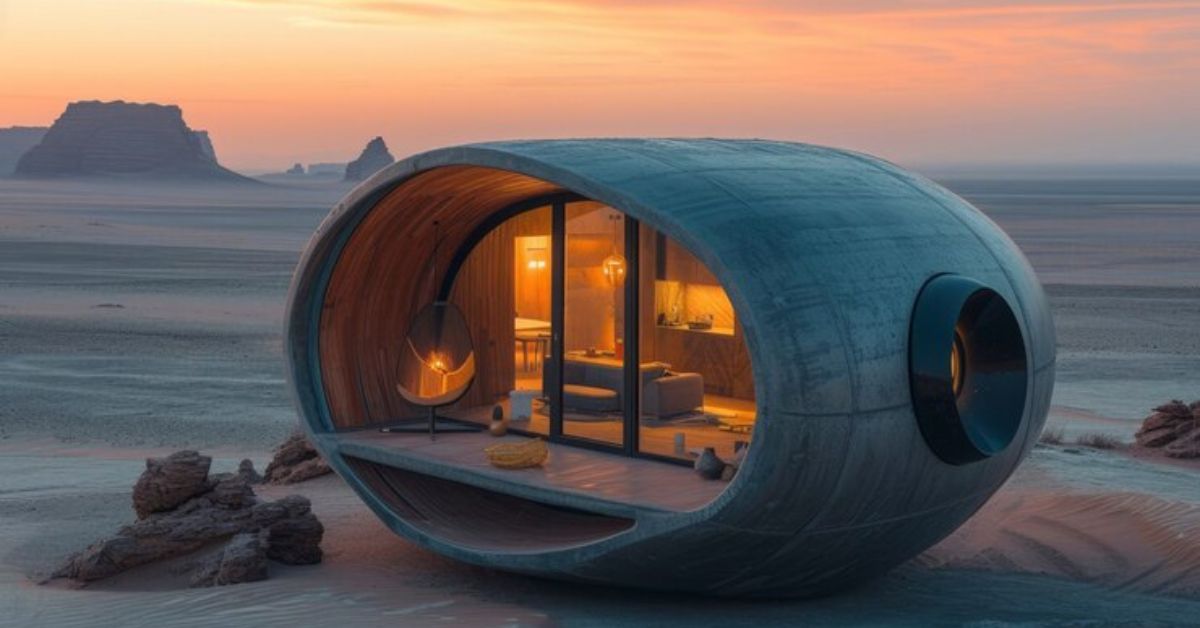Blog
Pod House: A Modern Take on Compact Living

In today’s world, where space is increasingly limited and sustainability is more important than ever, the concept of the pod house is gaining significant traction. Offering a minimalist approach to living, a pod house is designed to maximize functionality in a small, self-contained space. These compact homes have become a popular solution for urban dwellers, vacationers, and those looking for a sustainable lifestyle. But what exactly is a pod house, and why are they becoming so popular?
What is a Pod House?
A pod house is a small, self-sustaining living space that typically features a modern and compact design. These homes are usually prefabricated or modular structures that emphasize efficiency, simplicity, and sustainability. Pod houses can vary in size, but they are generally much smaller than traditional homes, offering just the essential living spaces, such as a bedroom, bathroom, and small kitchen.
The idea behind pod houses is to make the most out of minimal space while still providing the comforts of home. With the rise of tiny living and off-the-grid lifestyles, pod houses are an ideal solution for those who value minimalism and freedom from traditional home ownership.
Also Read: The Role and Impact of the IR2M00 Mistress: A Comprehensive Guide
Key Features of Pod Houses
1. Space-Efficiency
Pod houses are designed to use space efficiently, offering a compact living area that doesn’t feel cramped. Creative use of design elements, such as multi-functional furniture, built-in storage, and open floor plans, ensures that every inch of the pod serves a purpose.
2. Sustainability
Many pod houses are built with sustainable materials, like recycled wood, eco-friendly insulation, and energy-efficient appliances. The small size of these homes makes them ideal for energy conservation, as they require less heating and cooling than traditional homes. Some pod houses are even designed for off-grid living, utilizing solar panels, rainwater collection, and composting toilets.
3. Mobility
One of the key advantages of pod houses is their portability. Many pod houses are designed to be movable, allowing owners to relocate their homes as desired. This is particularly beneficial for those who prefer a nomadic lifestyle or wish to avoid long-term commitments to a specific location.
4. Modular Design
Most pod houses follow a modular design, meaning they can be customized or expanded to suit the needs of the occupant. Additional pods can be added to create more living space or to accommodate specific needs, such as a home office or a guest bedroom.
Types of Pod Houses
1. Prefabricated Pod Houses
Prefabricated pod houses are built off-site and then transported to the desired location. These homes are typically made from pre-engineered components that are assembled quickly, minimizing construction time and cost. Prefabricated pod houses can be made from a variety of materials, including steel, wood, and concrete, depending on the manufacturer and design preferences.
2. Shipping Container Pods
Shipping container pods are made from recycled shipping containers, which are repurposed into living spaces. These pods are strong, durable, and often come at a lower cost compared to other pod houses. The modular nature of shipping containers allows for easy expansion, and many people use them to create eco-friendly, affordable homes.
3. Tiny House Pods
Tiny house pods are a subset of pod houses that prioritize minimalism and efficient design. These homes typically range from 100 to 400 square feet and are designed to function as complete living spaces. Tiny house pods often feature fold-out furniture, convertible spaces, and compact appliances to make the most of their limited square footage.
4. Glamping Pods
Glamping pods are a type of pod house designed for luxury camping experiences. These pods are often located in scenic areas, such as forests or mountains, and offer a unique blend of nature and comfort. Glamping pods are typically equipped with amenities like comfortable bedding, private bathrooms, and small kitchenettes, making them a popular choice for vacationers looking for a more comfortable outdoor experience.
Benefits of Living in a Pod House
1. Lower Costs
One of the most significant advantages of pod houses is their affordability. Because they are smaller and often prefabricated, pod houses are typically less expensive to build than traditional homes. In addition to lower construction costs, pod house owners can also save money on utilities and maintenance due to the small size and energy-efficient features of the home.
2. Flexibility
Pod houses provide flexibility in terms of location and design. Their portability allows owners to move them to different locations, whether it’s for personal preference or a change in job or lifestyle. Additionally, modular designs allow for easy expansion, enabling the pod house to grow with the owner’s needs.
3. Minimalist Lifestyle
Living in a pod house encourages a minimalist lifestyle, where possessions are pared down to the essentials. This can lead to a greater sense of freedom and less clutter in one’s life. For many, pod houses symbolize a shift away from consumerism and towards a more sustainable, intentional way of living.
4. Sustainability
As mentioned earlier, pod houses are often built with sustainability in mind. Many incorporate renewable energy sources like solar power, water-saving devices, and eco-friendly materials. The small size of the home also reduces the environmental footprint, as less energy is required for heating and cooling.
Challenges of Pod Houses
1. Limited Space
While pod houses maximize the use of available space, the limited square footage can be a challenge for some individuals or families. Living in a pod house may require significant lifestyle adjustments, as it often means giving up unnecessary possessions and finding creative ways to make the most of the available space.
2. Zoning and Legal Issues
In some areas, zoning laws and building codes may restrict the construction or placement of pod houses. Before committing to a pod house, it’s essential to check local regulations to ensure that these homes are allowed and that they meet all necessary requirements.
3. Lack of Privacy
Given their compact nature, pod houses may lack the level of privacy found in traditional homes. Depending on the design, some pod houses may have thin walls or open layouts that make it difficult to create separate spaces for different activities.
How to Choose the Right Pod House
1. Consider Your Needs
Before choosing a pod house, think about your lifestyle and needs. Are you looking for a mobile home, or do you want a stationary living space? Will you be living alone or with a partner or family? These questions will help determine the right type of pod house for your needs.
2. Budget
Budget is an essential factor in choosing a pod house. While pod houses are generally more affordable than traditional homes, costs can still vary depending on the size, materials, and features you choose. Be sure to factor in additional costs like land, utilities, and maintenance.
3. Location
The location of your pod house is another crucial consideration. Make sure you choose a location that fits your lifestyle and offers the necessary utilities and infrastructure. If you plan on living off the grid, ensure that the site allows for solar panels, rainwater collection, and other sustainable living options.
Conclusion
Pod houses are a modern, efficient, and sustainable solution to the challenges of modern living. Whether you’re seeking a minimalist lifestyle, looking to reduce your environmental footprint, or simply interested in compact living, a pod house may be the perfect fit. With their affordability, mobility, and customizable designs, pod houses are revolutionizing the way we think about homeownership.
FAQs
What is the average size of a pod house?
Pod houses typically range from 100 to 400 square feet, depending on the design and layout.
Can pod houses be moved?
Yes, many pod houses are designed to be portable, allowing them to be moved to different locations.
Are pod houses energy-efficient?
Yes, pod houses are often built with energy-efficient materials and features, making them environmentally friendly and cost-effective.
Do pod houses require a foundation?
Some pod houses require a foundation, while others can be placed directly on the ground or a platform.
Are pod houses legal to live in?
Zoning and building codes vary by location, so it’s important to check local regulations before living in a pod house.
Blog
StateKaidz.com: Features, Benefits, and Future Insights

Navigating the maze of state aid can feel like trying to find your way out of a labyrinth. Fortunately, StateKaidz.com is here to guide you through the twists and turns, making the journey toward securing financial assistance more straightforward and less intimidating.
What is StateKaidz.com?
StateKaidz.com is a comprehensive online platform designed to assist individuals and organizations in accessing a wealth of resources related to various state-level requirements. Whether you’re a student seeking educational grants, a small business owner looking for funding opportunities, or someone in need of healthcare assistance, this website serves as a one-stop-shop for all your state aid needs.
Key Features of StateKaidz.com
The platform boasts several features aimed at simplifying the process of finding and applying for state aid:
- User-Friendly Interface: The website is designed with simplicity in mind, ensuring that even those who aren’t tech-savvy can navigate it with ease.
- Comprehensive Database: StateKaidz.com offers an extensive database of information on a wide array of state-related topics, including business registration, tax requirements, public services, and legal regulations.
- Regular Updates: The platform provides timely updates about changes in laws, new policies, and other essential information that could impact users.
- Resource Links: In addition to the information provided on the website, StateKaidz.com offers direct links to official state websites and resources, allowing users to verify information and access primary documents.
How to Apply for State Aid Using StateKaidz.com
Applying for state aid can seem daunting, but with StateKaidz.com, the process becomes more manageable:
- Gather Necessary Documents: Before starting your application, ensure you have all required documents, such as proof of income, identification, and relevant financial records.
- Explore Available Programs: Use the platform to research various aid programs that suit your needs.
- Follow Detailed Instructions: The website provides step-by-step guidance on the application processes for different programs.
- Submit Your Application: After carefully filling out the forms, submit your application through the appropriate channels.
- Monitor Your Application Status: Keep track of your application’s progress via the platform or by contacting support services.
Common Misconceptions About State Aid
Many individuals hesitate to apply for state aid due to prevalent myths:
- “State aid is only for those in dire financial situations.” In reality, various programs cater to a wide range of needs, from education to business development.
- “The application process is too complicated.” While some applications require detailed information, many are straightforward, especially with the guidance provided by StateKaidz.com.
- “Receiving state aid will hinder future opportunities.” On the contrary, many recipients use state aid as a stepping stone toward better prospects.
Benefits of Using StateKaidz.com
Utilizing StateKaidz.com offers numerous advantages:
- Simplified Process: The platform breaks down complex information into easily digestible content.
- Time Efficiency: With all resources in one place, you save time searching for information across multiple sites.
- Community Support: Connect with others who have navigated the state aid process, gaining insights and advice.
Success Stories from StateKaidz.com Users
Many have benefited from the resources provided by StateKaidz.com:
- Sarah, a Single Mother from Texas: She found grants to cover her child’s education expenses through the platform.
- John, an Aspiring Entrepreneur: Discovered funding opportunities that enabled him to start his own business.
Tips for Maximizing State Aid Opportunities
To make the most of the resources available:
- Stay Informed: Regularly check for updates on new programs or changes to existing ones.
- Network: Engage with community groups or forums to learn from others’ experiences.
- Be Proactive: Don’t hesitate to seek assistance or clarification when needed.
Conclusion
StateKaidz.com is an invaluable tool for anyone looking to navigate the complex world of state aid. By providing comprehensive resources, user-friendly navigation, and up-to-date information, it empowers users to access the assistance they need to improve their lives.
FAQs
Is StateKaidz.com free to use?
Yes, the platform is free for all users.
Do I need to create an account to access information?
While creating an account can enhance your experience, it’s not mandatory to access most resources.
How often is the information updated?
The platform regularly updates its content to ensure users have the most current information.
Can I apply for multiple aid programs simultaneously?
Yes, depending on eligibility requirements, you can apply for multiple programs.
Who can I contact for further assistance?
StateKaidz.com offers support services to help guide you through the process.
Blog
Unveiling Onedayform.com: Simplifying Online Forms

Onedayform.com is an innovative online platform designed to simplify the process of creating, managing, and sharing forms. It’s a one-stop solution for businesses, educators, and individuals seeking a streamlined approach to online form generation.
Why Online Forms Are Crucial Today
Forms play a vital role in digital interactions. Whether it’s for feedback, surveys, registrations, or data collection, efficient online forms make communication seamless. Onedayform.com takes this necessity to the next level with its user-friendly interface and advanced features.
Key Features of Onedayform.com
1. Intuitive User Interface
Navigating Onedayform.com is a breeze. Its straightforward design ensures that users can create forms without prior technical knowledge.
2. Customizable Templates
The platform offers a range of templates tailored to different needs. From business surveys to event registrations, there’s something for everyone.
3. Real-Time Collaboration
Users can collaborate with team members in real-time, making it easier to work together on form creation and editing.
4. Integration with Popular Tools
Onedayform.com seamlessly integrates with tools like Google Sheets, Excel, and CRM software, enhancing its utility.
5. Data Security
Prioritizing user data safety, the platform incorporates robust encryption and compliance with global privacy standards.
Benefits of Using Onedayform.com
1. Time Efficiency
Onedayform.com is built to save time. The templates, drag-and-drop features, and automation options ensure you can create forms in minutes.
2. Cost-Effective
Unlike hiring developers or purchasing expensive software, Onedayform.com provides a budget-friendly alternative for creating professional forms.
3. Versatility
It’s not just for businesses. Educators, event organizers, and even freelancers can find value in the platform.
4. Enhanced Engagement
Interactive elements like conditional logic and multimedia integration help boost user engagement with the forms.
Who Can Benefit From Onedayform.com?
1. Businesses
Companies can use it for customer feedback, employee surveys, and lead generation.
2. Educational Institutions
Schools and universities can simplify enrollment processes, feedback forms, and academic surveys.
3. Event Organizers
From RSVPs to post-event surveys, Onedayform.com is a game-changer for event management.
4. Non-Profit Organizations
NGOs can streamline donation forms and volunteer registration processes.
How Onedayform.com Stands Out
Ease of Use
Many platforms offer online form creation, but Onedayform.com excels with its intuitive design.
Mobile Compatibility
The platform is optimized for mobile devices, ensuring forms are accessible anytime, anywhere.
Frequent Updates
The developers behind Onedayform.com continually enhance the platform, ensuring it stays relevant and functional.
Creating Your First Form on Onedayform.com
Step 1: Sign Up
Register on the platform with your email address and set up a secure password.
Step 2: Choose a Template
Browse through the available templates and select one that fits your needs.
Step 3: Customize Your Form
Use the drag-and-drop editor to add, remove, or rearrange form elements.
Step 4: Share Your Form
Generate a shareable link or embed the form directly into your website or emails.
Step 5: Collect and Analyze Data
Monitor form responses in real-time and export the data for analysis.
Common Use Cases for Onedayform.com
1. Customer Feedback Forms
Gain insights into customer preferences and improve your services.
2. Event Registration
Simplify attendee sign-ups with customizable event forms.
3. Surveys and Polls
Conduct market research or internal polls effortlessly.
4. Job Applications
Streamline recruitment with easy-to-manage application forms.
Tips for Maximizing Onedayform.com’s Potential
- Use clear and concise questions to avoid confusing respondents.
- Leverage conditional logic to personalize the user experience.
- Regularly update and refine your forms based on feedback.
Why Onedayform.com Is Worth Trying
Its blend of simplicity, versatility, and affordability makes Onedayform.com a must-have tool for anyone needing efficient online forms. Whether you’re an individual or part of a large organization, the platform adapts to your unique needs.
Conclusion
Onedayform.com is revolutionizing the way we create and use online forms. Its user-centric features, affordability, and robust performance make it a standout choice in the market. Give it a try and experience the difference for yourself!
FAQs
Is Onedayform.com free to use?
The platform offers both free and premium plans, catering to various user needs.
Can I integrate forms with my website?
Yes, Onedayform.com allows you to embed forms directly into your website.
Is my data safe on Onedayform.com?
Absolutely. The platform prioritizes data security with advanced encryption and compliance measures.
Does Onedayform.com work on mobile devices?
Yes, it’s fully optimized for mobile, ensuring accessibility on the go.
Can I collaborate with others on form creation?
Yes, real-time collaboration is one of the standout features of Onedayform.com.
Blog
Start RandomGiantNet Blog: A Comprehensive Guide for Beginners

Starting a blog is one of the most rewarding ways to share your knowledge, express creativity, and even build a sustainable source of income. If you’ve stumbled upon the idea of creating a Start RandomGiantNet Blog, you’re in for an exciting adventure. The concept of a “RandomGiantNet” blog suggests flexibility, variety, and endless possibilities to discuss diverse topics under one brand. Whether you’re starting as a hobby or aiming to monetize your efforts, this guide will take you step by step through the process of creating, designing, and growing your blog.
What Is a RandomGiantNet Blog?
A RandomGiantNet blog is essentially a multi-topic platform where you can cover an array of subjects ranging from personal interests, trending topics, niche industries, or even random ideas. Unlike single-topic blogs that focus narrowly on one area, a RandomGiantNet blog offers the freedom to explore multiple topics, allowing you to attract a diverse audience.
The beauty of such a blog is its flexibility. You’re not tied to a single niche, and you can pivot or expand based on audience preferences, your expertise, or new trends. This makes it a perfect choice for people with varied interests or those who want to experiment with content creation.
Step 1: Define Your Vision and Purpose
Before diving into the technical aspects of starting your blog, it’s essential to clarify your vision. Ask yourself the following questions:
- What topics am I passionate about, and how can they add value to readers?
- Who is my target audience?
- Do I want to blog for fun, build a personal brand, or generate income?
Defining your blog’s purpose will help you make key decisions about its structure, tone, and long-term goals. For instance, if you want to monetize the blog, you might focus on SEO (Search Engine Optimization) and affiliate marketing strategies. On the other hand, if it’s purely a creative outlet, your focus might be on storytelling or unique design.
Step 2: Choose a Blogging Platform
One of the first technical decisions you’ll make is selecting a blogging platform. The platform you choose will determine how easy it is to set up, design, and manage your RandomGiantNet blog. Popular blogging platforms include:
- WordPress.org: A highly customizable, self-hosted platform that gives you full control over your blog.
- Blogger: Google’s free blogging platform, best for beginners who want simplicity.
- Wix or Squarespace: User-friendly drag-and-drop website builders that offer built-in blogging tools.
For a RandomGiantNet blog with multiple categories and scalability, WordPress.org is often the best choice because of its flexibility, plugins, and themes.
Step 3: Pick a Domain Name and Hosting Service
Your domain name is your blog’s address on the internet (e.g., www.randomgiantnet.com). Since branding is critical, your domain name should be:
- Memorable: Keep it short and easy to spell.
- Relevant: Incorporate “RandomGiantNet” or something closely related to your blog’s vision.
- Unique: Avoid using names that are too similar to existing blogs or websites.
After choosing your domain name, you’ll need a hosting service to make your blog accessible online. Reliable hosting providers include Bluehost, SiteGround, and HostGator. Many hosting services offer affordable plans for beginners, and some even include free domain registration for the first year.
Step 4: Set Up and Customize Your Blog
Once your domain and hosting are ready, it’s time to set up your blog.
- Install Your Blogging Platform: If you’re using WordPress, most hosting providers have one-click installation features.
- Choose a Theme: Your theme determines the visual layout and design of your blog. For a RandomGiantNet blog, select a versatile theme that allows multiple categories and a clean, user-friendly interface. Popular themes like Astra or OceanWP offer extensive customization options.
- Customize Your Blog: Adjust the theme’s colors, fonts, and layout to align with your brand. Don’t forget to add your blog’s logo and tagline.
Make sure your blog design is mobile-friendly since most users access websites on their phones.
Step 5: Plan Your Content Strategy
Content is the heart of any blog. For a RandomGiantNet blog, planning your content strategy is particularly important because you’ll be covering multiple topics. Here’s how to do it effectively:
- Brainstorm Categories: Divide your blog into broad categories, such as travel, tech, food, personal growth, or entertainment. These categories will help you organize your content and make navigation easier for readers.
- Create a Content Calendar: Plan your posts in advance to maintain consistency. For example, you could schedule new posts every Monday and Thursday to keep your audience engaged.
- Focus on Quality: Write well-researched, engaging posts that provide value to readers. Use conversational language to connect with your audience.
Step 6: Optimize Your Blog for SEO
SEO (Search Engine Optimization) is crucial if you want your blog to rank high on Google and attract organic traffic. Here are some key SEO tips for your RandomGiantNet blog:
- Keyword Research: Use tools like Google Keyword Planner or Ubersuggest to identify popular search terms in your niche.
- On-Page SEO: Include keywords naturally in your titles, headings, meta descriptions, and content. Avoid keyword stuffing.
- Internal Linking: Link related posts within your blog to improve navigation and keep readers engaged.
- Fast Loading Speed: Optimize images and use caching plugins to ensure your blog loads quickly.
Step 7: Promote Your Blog
Creating great content is only half the battle; you also need to promote your blog to reach a wider audience. Here are some effective strategies:
- Social Media: Share your posts on platforms like Facebook, Instagram, and Twitter. Tailor your content for each platform.
- Email Marketing: Build an email list and send regular newsletters to your subscribers. Offer a free resource (like an eBook or guide) to encourage sign-ups.
- Networking: Connect with other bloggers and participate in blogging communities to build relationships and gain visibility.
Consistency and persistence are key when it comes to blog promotion.
Step 8: Monetize Your Blog
If your goal is to earn income from your RandomGiantNet blog, there are several monetization strategies to explore:
- Display Ads: Sign up for ad networks like Google AdSense to display ads on your blog and earn revenue based on clicks or impressions.
- Affiliate Marketing: Recommend products or services and earn a commission for each sale made through your referral links.
- Sponsored Posts: Partner with brands to create sponsored content.
- Sell Products or Services: Offer eBooks, courses, or consulting services tailored to your audience’s interests.
Be patient, as monetizing a blog often takes time and consistent effort.
Step 9: Track Your Performance
Use analytics tools like Google Analytics to monitor your blog’s performance. Track metrics such as page views, bounce rates, and audience demographics to understand what’s working and what needs improvement. Use this data to refine your content strategy and grow your blog effectively.
Step 10: Stay Consistent and Adaptable
Running a successful RandomGiantNet blog requires consistency and adaptability. Regularly publish high-quality content, engage with your audience, and stay updated on blogging trends. Be open to experimenting with new topics or formats based on reader feedback and analytics.
Conclusion: Start RandomGiantNet Blog
Start RandomGiantNet Blog is an exciting journey that combines creativity, technical skills, and perseverance. By following this step-by-step guide, you can set up a professional and engaging blog that resonates with a diverse audience. Remember, the key to success lies in delivering value, staying consistent, and continuously learning as you grow. Whether your goal is to share your passions, build a community, or generate income, your RandomGiantNet blog has the potential to become a powerful platform for self-expression and connection.
-

 Tech5 months ago
Tech5 months agoUnderstanding the DarkZadie Ren Telegram Community and Its Impact
-

 General5 months ago
General5 months agoAdeena Mendel: An Exploration of Her Work and Impact
-

 Education5 months ago
Education5 months agoSkillsClone.com: A Deep Dive into Its Learning and Development Tools
-

 News4 months ago
News4 months agoBreaking Down the Latest Updates on News JotechGeeks
-

 Crypto5 months ago
Crypto5 months agoiCryptoX: Navigating the Future of Digital Currency and Security
-

 General5 months ago
General5 months agoThe Ultimate Guide to Choosing and Customizing a Pink Golf Cart
-

 Entertainment5 months ago
Entertainment5 months agoThe Sburb Talk Drama: A Look into Online Fandom Conflicts
-

 Wild Life5 months ago
Wild Life5 months agoJuquana Pajaro: A Comprehensive Guide to Its Beauty and Significance
